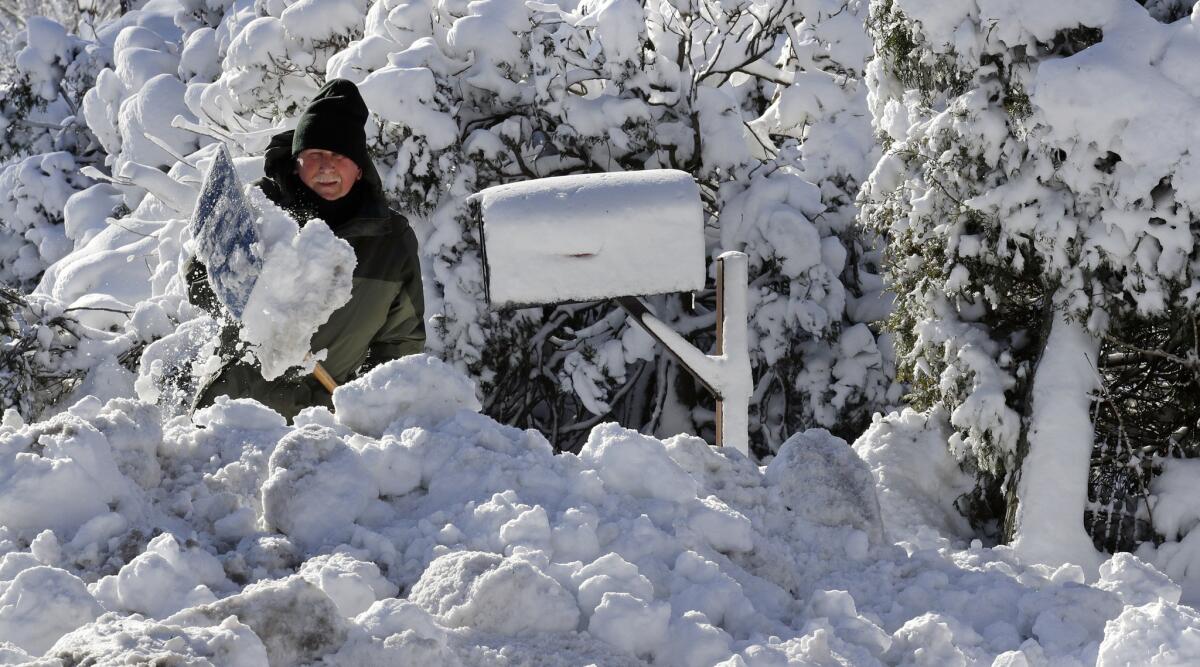New Hampshire’s Mt. Washington bracing for a wind chill of 100 degrees below zero

- Share via
When the plumber crawled along the ground, blowtorch in hand, Julie Beroukas Snyder realized just how cold it was.
The dirt was too frozen to get to the pipes, also frozen, under her home in Camp Hill, Pa., forcing the plumber to first heat the ground so he could dig. The high for the day was 15 degrees.
The Wisconsin native said she challenges herself each winter with how long she can go without a coat. She’s wearing coats now. The cold temperatures chilling much of the Eastern United States have made even the hardiest of residents shiver.
“It’s really windy, and that certainly just sucks the life out of you,” Beroukas Snyder, 32, said.
In New Hampshire, at the Mt. Washington Observatory — atop the tallest peak in the Northeast — meteorologists forecast that the wind chill was expected to reach negative-100 degrees Friday night into Saturday, bringing the coldest combination of temperature and wind seen in more than a decade in the White Mountains. Under those conditions, the effects of hypothermia and frostbite could take hold within a few minutes, they warned.
Across the United States, a cold spell that has lasted more than a week is expected to continue. Temperatures across the Northeast are forecast to be 20 to 30 degrees below normal for early January, with many locations struggling to get above the single digits. Some cities in the South will see temperatures 25 degrees below normal.
If anyone could complain about the cold, it would be Mainers, where the wind chills will make it feel as cold as negative-40 degrees Friday night.
On Friday afternoon in Wells, Maine, customers at the Maine Diner — advertising “World Famous Food Like Grandma Used to Make!” — came in seeking coffee and clam chowder to warm up.
“They’re saying it’s cold,” said manager Julie Bonser. “They’re saying it’s really cold.” This is true. It was 7 degrees.
It took some of the wait staff a few hours to dig out their cars, removing thick, frozen snow.
Bonser said that whereas she planned to stay indoors as much as possible, her husband and teenager had gone skiing in New Hampshire. Living in the Northeast will teach you to adapt.
“This is kind of how it goes,” Bonser said. “It’s how winter is. Not all of us prefer this kind of weather, me included, but you have a choice. You either live here or deal with it, or could choose to move, so we all deal with it.”
At times, this week’s storm has seemed apocalyptic, bringing rare sites like frozen sharks to shore in Cape Cod and freezing a small Iowa town’s water tower. In Florida, it snowed in Tallahassee (for an hour), and cold-stunned iguanas fell from trees.
In Massachusetts, Provincetown Town Manager David Panagore faced the more serious issues of the storm, as the popular tourist destination was one of many towns and cities that saw coastal flooding Thursday afternoon.
Along Commercial Street, which runs parallel to the coast, water flooded several restaurants’ and other businesses’ basements. In one commercial building, its 8,000-square-foot basement filled with 7 feet of water.
“There was a river running down a side street 300 yards from the shore, and ducks and other animals swimming around these rivers that didn’t exist 15 minutes before,” Panagore said.
The “bomb cyclone” also brought the normal cold-weather issues: delayed and canceled flights, icy streets and highways, and schools closed. On Friday, almost 1,500 flights in the United States were canceled.
In Tampa, Fla., 26-year-old Megan Penney sat in the airport, counting the number of times her flight to John F. Kennedy International Airport in New York had been delayed (three times, by Friday afternoon). The New York native had visited Florida to spend New Year’s Eve with a friend, booking the trip weeks in advance.
At the very least, Penney was grateful that she had escaped some of the cold weather that hit New York. Back at her apartment in Harlem, it was 15 degrees, versus 51 degrees in Tampa.
“To me, it feels like a nice spring day, but for people in Florida, there are people wearing fur jackets, hats, scarves and gloves in 40 degrees,” Penney said. “They’re not really used to this.”
In New York, a food rescue organization called City Harvest set up its usual farmers-market-style booth indoors. But Pedro Urbaez, 35, still had to spend time outside to haul in the fruits and vegetables the group gives to residents for free.
In New York City, the main concerns over the weekend are frigid temperatures and dangerous wind chills. On Friday night, lows were expected to drop into the single digits with wind chills 10 to 20 degrees below zero.
“We find this to not be that big of a deal,” Urbaez said. “That can be kind of strange. We haven’t had this kind of temperature in a very long time, but yet people are still reminiscing about how schools never closed back in 1996, and we used to go to work, regardless of how many feet of snow there is.… That’s the spirit of New York – we can deal with anything.”
More to Read
Sign up for Essential California
The most important California stories and recommendations in your inbox every morning.
You may occasionally receive promotional content from the Los Angeles Times.











